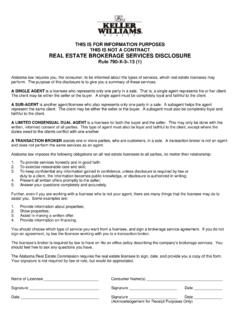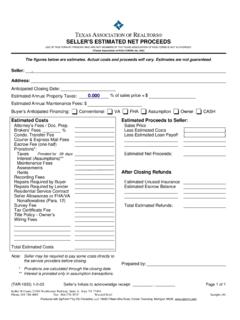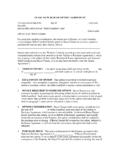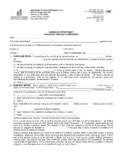Transcription of Your Guide to the California Residential Purchase …
1 Presents Your Guide to the California Residential Purchase agreement California Department of Real Estate Disclaimer Statement: This course is approved for Continuing Education credit by the California Department of Real Estate. However, this approval does not constitute an endorsement of the views or opinions which are expressed by the course sponsor, instructor, authors or lecturers. This course will discuss the entire revised October 2002 California Residential Purchase agreement and Joint Escrow Instructions (RPA-CA) and related addenda. The new Purchase agreement and related addenda contain the essential terms for the formation of a real estate contract. The RPA-CA is a multi-functional document. It serves as: an offer to Purchase real property; a completed contract when it is signed by the buyer and seller and communication of the acceptance is received; a receipt for the good faith earnest money deposit; joint escrow instructions; a mediation and arbitration agreement ; a confirmation of the agency relationships; and an irrevocable assignment of compensation to brokers.
2 The Purchase agreement is adequately detailed to address most issues involved in the Purchase and sale of real property. Extensive modification or drafting of additional paragraphs may be considered to be the unauthorized practice of law and should be avoided. Downloadables If you have Adobe Acrobat Reader installed, you can view and print files for reading offline. To view a file, click on its link, or SHIFT and right-click to save it to your computer. The file size is provided to allow you to gauge the download time for the file. 1. Forms are displayed/reprinted with permission, California ASSOCIATION OF REALTORS. Endorsement not implied. 2. Entire forms must be reproduced with the word "Sample" screened across every page of each form. 3. The forms must be reproduced and displayed/reprinted in their entirety. California Residential Purchase agreement (RPA-CA): (142K) Buyer's Inspection Advisory (BIA) attached to the RPA-CA: (90K) Title The word " California " reflects the fact that the form is available for use throughout the state.
3 The words "and Joint Escrow Instructions" reflect that the form includes an instruction to the escrow holder by both the buyer and the seller (see paragraph 28) and includes space for the escrow holder to sign for receipt of the document (see page 8 of the contract). Date Date: The date inserted is the date of preparation. This is usually, but not always, the date the buyer signs the offer and the earnest money is received. The important point is that the "contract date" is the date of final acceptance, provided that the acceptance has been personally communicated. All dates and time periods in the agreement are counted from the date of final acceptance, unless otherwise specified. Location: The city inserted is the place where the document is drafted. This is usually, but not always, the city where the buyer signs the document or the city where the property is located. This may help to determine the "venue" in the event of a dispute. 1. Offer A. Offer/Buyers This sentence identifies the document as being an offer.
4 As such, it is capable of being accepted as defined later in the document, and creating a binding contract. It also informs the seller of the identity of the buyers. This aspect is important for offers that have seller financing. Here is where the buyers' names are listed--not "assignee" or "nominee." All buyers should be listed, even if not all buyers have signed. Do not identify the buyers with anything that looks like a manner of taking title ( , husband and wife, an unmarried man, etc.). There is no place in the agreement to designate vesting so that you will not be tempted to give tax or legal advice. This may also avoid any claim of discrimination based upon familial status under the Federal Fair Housing laws. Description: Clearly identify the property by address or legal description. B. Real Property to be Acquired This is the description of the property for Purchase . There is also a space for the assessor's parcel number. C. Purchase Price: This is the price the buyer offers to pay the seller.
5 It does not include closing costs, insurance premiums or funding fees that the buyer may also be required to pay. D. Close of Escrow Choose either a specific date for the close of escrow (COE) or a certain number of days after the offer is accepted for the close of escrow. Some buyers or sellers may have to close by a certain date for tax reasons (such as a tax deferred exchange or sale of a principal residence capital gains exclusion), employment transfers, or other personal reasons. If either party requires a "date specific" COE, be sure to address that in the contract. 2. Financing Obtaining of the loans specified is a contingency of the agreement , unless this is an all cash offer or unless the buyer specifies that getting a loan is not a contingency. The buyer is required to make a good faith effort to obtain the specified financing. If a contingency fails, the buyer is not (1) obligated to perform nor (2) held liable for breach of contract damages. Obtaining deposit, down payment and closing costs are not contingencies.
6 If the buyer does not have or cannot get the money for these items, seller may be entitled to legal remedies, such as keeping the buyer's deposit or canceling the sale. The buyer represents that the funds will be good when deposited with escrow. Again, this is a promise by the buyer, not a contingency. If there is not enough money in an account to cover a check given to escrow, the buyer could be in breach of the contract. The seller may be entitled to cancel the sale. A. Initial Deposit The deposit is given to the agent submitting the offer. Usually this is the buyer's agent but may be a dual agent or seller's exclusive agent on an in-house sale. If given to anyone else, that should be specified in the blank line. Indicate to whom the check is made payable. This will usually be the broker or a title or escrow company. Funds received in trust from a principal must not be commingled with a broker's own funds. Any violation may subject the broker to disciplinary action by the Real Estate Commissioner, including suspension or revocation of the real estate license.
7 In addition, deposits must be logged whether they are placed into the broker's trust account or into a neutral escrow account. Deposits must be disposed of properly by the third business day after receipt unless the parties contractually agree to another disposition. The contract authorizes holding the check uncashed until the third business day following acceptance of the offer, or some other choice that is specified in the blank line such as, "until this back-up offer is in primary position" or "the inspection contingency has been removed." Although a post-dated check is not illegal, it may affect the seller's decision and must be disclosed. Make sure to indicate where the deposit money will be placed (into escrow or broker's trust account or elsewhere). The deposit is to be made by a personal check unless a different form of deposit is specifically written into the blank line. The amount should be written out in numbers in the column to the right. If the deposit is not made on time, seller may be entitled to cancel the sale.
8 B. Increased Deposit For the increased deposit to be included in the amount of liquidated damages there must be a separate receipt for the increased deposit at the time that it is paid, in which case the buyer initials or signs the liquidated damages provision. ( Form RID complies with this requirement.) Fill in the number of days indicating when the increased deposit will be made or specify a particular condition such as "upon removal of the inspection contingency." The amount should be written out in numbers in the column to the right. As with the initial deposit, if the deposit is not made on time, seller may be entitled to cancel the sale. C. First Loan in the Amount Of This paragraph encompasses new first loans and can be either conventional or FHA/VA loans. Conventional Loans The first sub-paragraph only refers to conventional loans. Seller financing requires a seller-financing addendum and should be referenced in the "Additional Financing Terms" (2D) paragraph.
9 Secondary financing and assumptions require an addendum (such as Form PAA) and the appropriate box checked in paragraph 2D. List only the loan amount and not financing charges or origination fees that might be included. The terms should be set forth specifically and not left to future interpretation. Do not use "best available rate and terms." Allow for market fluctuations by using the upper limits of what the buyer will pay. If the market is lower, the lender will use the current market rate and the buyer will not complain! If both the fixed rate and the adjustable rate information are filled in, then the buyer is obligated to complete the transaction with whichever option is obtainable from the lender. If the buyer does not want an adjustable rate loan, then be sure not to complete those blanks. Some loans are due in a short period of time, such as five or seven years, but payments are amortized over a longer period, such as 20 or 30 years. This can be specified in the agreement .
10 There is no place to select a "subject to" option. There is a significant liability for both the seller and the buyer on loans taken "subject to." If a loan with a due on sale clause is taken over "subject to" without the consent of the lender, the loan may be accelerated (called immediately due and payable). The buyer may lose the property to foreclosure if unable to secure new financing. The seller may be held personally liable for the amount of the loan or the amount of the deficiency, if permitted by law. A deficiency is the difference between the actual loan amount and the amount the lender actually receives from the property at sale. Deficiency judgments are not permitted by law (except for VA) under the following circumstances: if the loan was originally a Purchase money loan on a one-to-four unit, single family owner-occupied dwelling; if the foreclosure is by trustee sale; or if the loan was a seller carry-back. The above exemptions do not apply to VA loans.














